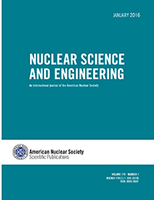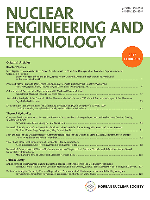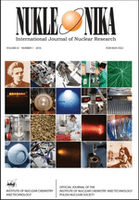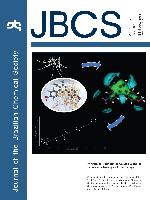
JOURNAL OF RADIOANALYTICAL AND NUCLEAR CHEMISTRY
Scope & Guideline
Exploring the depths of radioanalytical research.
Introduction
Aims and Scopes
- Radioanalytical Techniques:
The journal emphasizes the development and application of various radioanalytical techniques, including gamma spectrometry, liquid scintillation counting, neutron activation analysis (NAA), and mass spectrometry for the detection and quantification of radionuclides in environmental and biological samples. - Environmental Radioactivity:
Research on the natural and anthropogenic sources of radioactivity in the environment, including the study of radionuclide distribution, transport mechanisms, and the associated health risks, is a core focus area. - Nuclear Forensics and Safeguards:
The journal covers advancements in nuclear forensics, including the analysis of nuclear materials and the development of methodologies for the detection and characterization of illicit nuclear materials. - Radiopharmaceutical Development:
Papers on the development, synthesis, and application of radiopharmaceuticals for medical imaging and therapy are prevalent, reflecting the journal's commitment to the intersection of nuclear chemistry and healthcare. - Waste Management and Recycling:
The journal explores methodologies for the treatment, recycling, and safe disposal of radioactive waste, highlighting innovative approaches to mitigate environmental impacts. - Fundamental Research in Radiochemistry:
Theoretical and experimental studies that advance the fundamental understanding of radiochemical processes, including the behavior of actinides and fission products in various matrices, are essential contributions to the journal.
Trending and Emerging
- Advanced Materials for Radionuclide Removal:
There is a growing emphasis on the development of novel materials, such as functionalized nanomaterials and composites, for the efficient removal of radionuclides from wastewater and contaminated environments. This trend highlights the integration of materials science with radiochemistry. - Health Impact Studies:
Research focusing on the health impacts of radionuclides, including the assessment of exposure risks from sources like groundwater and environmental contaminants, is increasingly prominent. This reflects a broader societal concern regarding public health and environmental safety. - Machine Learning and Data Analysis in Nuclear Research:
The incorporation of machine learning and advanced data analysis techniques in nuclear research is on the rise, with studies utilizing these methods for predictive modeling and optimization of radionuclide separation processes. - Sustainable Practices in Nuclear Chemistry:
Emerging themes include sustainability in nuclear chemistry, focusing on eco-friendly methods for radionuclide extraction, waste management, and the use of biodegradable materials in radiochemical applications. - Interdisciplinary Approaches to Nuclear Forensics:
Increasingly, research is integrating concepts from various scientific disciplines to enhance nuclear forensics methodologies, reflecting a trend towards comprehensive approaches in safeguarding and nuclear security.
Declining or Waning
- Traditional Radiochemical Methods:
There has been a decline in studies focused solely on traditional radiochemical methods that do not incorporate new technologies or interdisciplinary approaches. As research evolves, there is a growing preference for methodologies that integrate advanced analytical techniques or novel materials. - Basic Radiochemical Studies:
Research that primarily focuses on basic radiochemical properties without application to real-world problems, particularly in environmental and health contexts, appears to be waning. The trend suggests a shift towards applied research with practical implications. - Conventional Waste Management Techniques:
Papers centered around conventional waste management techniques are becoming less common, as the field moves towards more innovative and sustainable solutions that incorporate advanced materials and methodologies.
Similar Journals

Acta Chemica Iasi
Championing Excellence in Chemical ResearchActa Chemica Iasi is a distinguished open-access journal dedicated to advancing the field of chemistry, published by the esteemed ALEXANDRU IOAN CUZA UNIVERSITY PRESS located in Iasi, Romania. Since its inception, this journal has served as a vital platform for the dissemination of significant research findings, theoretical advancements, and methodological innovations in various chemistry disciplines. As an open-access publication since 2013, it provides unrestricted access to high-quality articles, fostering collaboration and knowledge sharing among researchers, professionals, and students globally. Although specific metrics such as H-Index and Scopus rankings may be forthcoming, the journal's commitment to rigor and excellence ensures that it remains an invaluable resource for those seeking to stay at the forefront of chemical research. With a focus on promoting scientific inquiry and innovation, Acta Chemica Iasi continues to uphold a legacy of scholarly excellence and contribution to the chemical sciences.

Separation Science Plus
Exploring innovative breakthroughs in separation methodologies.Separation Science Plus is an emerging academic journal dedicated to advancing the field of analytical chemistry and separation science. Published by WILEY-VCH Verlag GmbH, this journal provides a platform for researchers to disseminate high-quality studies and reviews that address innovative techniques and breakthroughs in separation methodologies. With its ISSN 2573-1815, the journal has made significant inroads since its inception in 2018, encompassing a convergence period until 2024. Despite currently holding a Q3 ranking in Analytical Chemistry and a Q4 ranking in Filtration and Separation, its dedication to publishing impactful research makes it a vital resource for professionals and students alike. The journal operates under the robust scholarly reputation of WILEY, which is known for its commitment to excellence in scientific communication. Researchers interested in the latest advancements in separation techniques will find Separation Science Plus an essential read, fostering the exchange of knowledge and facilitating greater understanding within this specialized field.

Radiation Detection Technology and Methods
Empowering Knowledge in Radiation Detection MethodsRadiation Detection Technology and Methods is a prominent academic journal published by Springer Singapore Pte Ltd, dedicated to advancing the field of nuclear and high-energy physics, as well as nuclear energy and engineering. Established in 2017, this journal provides a platform for the dissemination of pioneering research and innovative methodologies in radiation detection technology. As of 2023, it holds a commendable Q2 ranking in both the categories of Nuclear and High Energy Physics and Nuclear Energy and Engineering, underscoring its significance in fostering scholarly discourse within these vital fields. With ISSN 2509-9930 and E-ISSN 2509-9949, the journal aims to cater to a diverse audience of researchers, professionals, and students, emphasizing open access to knowledge. The journal's contributions are particularly crucial for those engaged in the development of safer and more efficient radiation detection techniques, ultimately bridging the gap between theory and practical applications in energy security and health physics. For researchers seeking a dedicated outlet for their work, Radiation Detection Technology and Methods represents an invaluable resource and an opportunity to influence the future of radiation science.

NUCLEAR SCIENCE AND ENGINEERING
Connecting Academia and Industry in Nuclear ResearchNUCLEAR SCIENCE AND ENGINEERING, published by Taylor & Francis Inc, is a leading journal in the field of nuclear energy and engineering, providing a vital platform for disseminating cutting-edge research and advancements from both academia and industry. With an ISSN of 0029-5639 and an E-ISSN of 1943-748X, the journal boasts a notable impact factor and is categorized in the Q2 quartile for 2023, reflecting its influence and quality in the field. Covering a comprehensive scope from the inception of nuclear technology in 1969 to contemporary advancements forecasted for 2024, it ranks #38 out of 77 in the Scopus Energy – Nuclear Energy and Engineering category, placing it in the 51st percentile. Although the journal is not open access, it remains essential for researchers, professionals, and students seeking to stay abreast of the latest developments and innovations in nuclear science. Located in the heart of Philadelphia, NUCLEAR SCIENCE AND ENGINEERING contributes significantly to the advancement of nuclear engineering knowledge and practice, making it a crucial resource for anyone involved in this dynamic field.

Nuclear Engineering and Technology
Advancing the Future of Nuclear EnergyNuclear Engineering and Technology, published by the Korean Nuclear Society, is a premier Open Access journal dedicated to the rapidly evolving fields of nuclear energy and engineering. Established as a significant platform for scholarly communication since 2008, this journal has consistently anchored itself in the academic community, achieving a Q2 ranking in its category as of 2023, reflecting its influence and quality within the domain of Nuclear Energy and Engineering. With an impressive Scopus ranking of #15 out of 77, positioning it in the 81st percentile, the journal publishes cutting-edge research that addresses both fundamental and applied aspects of nuclear technology. Nuclear Engineering and Technology embraces an open access model since 2013, ensuring that valuable research is accessible to a global audience, thereby enhancing collaboration among researchers, professionals, and students passionate about advancing nuclear technology. The journal serves as an essential resource for those aiming to innovate and push the boundaries of knowledge in nuclear sciences.

NUKLEONIKA
Leading the Charge in Open Access Scientific InquiryNUKLEONIKA, published by SCIENDO, is a leading open access journal that has been serving the scientific community since its establishment in 1968. Focused on the domains of Nuclear and High Energy Physics, Condensed Matter Physics, and Nuclear Energy and Engineering, this journal provides a platform for innovative research and technological advancements in a variety of interdisciplinary fields. With an impressive history of publications and a current Q3 ranking in several categories, including Safety, Risk, Reliability and Quality and Waste Management and Disposal, NUKLEONIKA is recognized for its significant contributions to scientific discourse. Open access since 2014, the journal ensures that all research outputs are freely available, facilitating broad dissemination and accessibility for researchers, professionals, and students alike. Located in the heart of Warsaw, Poland, NUKLEONIKA aims to inspire collaborative efforts and foster a deeper understanding of complex physical phenomena and their practical implications.

RADIATION PHYSICS AND CHEMISTRY
Illuminating Innovations in Radiation StudiesRADIATION PHYSICS AND CHEMISTRY, published by Pergamon-Elsevier Science Ltd in the United Kingdom, stands as a leading journal in the field of radiation studies, bridging fundamental research and practical applications. With an impressive 2023 Scopus Rank of 11 out of 58 in the Radiation category, reflecting an 81st percentile ranking, the journal maintains a robust reputation within the scientific community. The journal focuses on the experimental and theoretical aspects of radiation physics, chemistry, and their interdisciplinary applications, providing critical insights that aid the advancement of knowledge in various domains, including nuclear energy, materials science, and healthcare. Although open access options are not available, the journal garners substantial readership and engagement from researchers, professionals, and students alike, as it publishes innovative studies and reviews from 1985 through to its anticipated conclusion in 2025. The ISSN for the journal is 0969-806X, with the E-ISSN being 1879-0895, ensuring global accessibility to cutting-edge research in radiation science.

ATOMIC ENERGY
Exploring the frontiers of nuclear energy and engineering.ATOMIC ENERGY is a distinguished journal published by SPRINGER, focusing on pivotal advancements and research within the field of Nuclear Energy and Engineering. With an ISSN of 1063-4258 and an E-ISSN of 1573-8205, this journal has been a critical resource since its inception in 1956, serving both historic and contemporary scientific inquiries into nuclear technologies. Currently positioned in Q3 of the Nuclear Energy and Engineering category, ATOMIC ENERGY ranks 49 out of 77 in Scopus, representing a percentile of 37%, highlighting its relevance in the research community. While it is not an open access journal, it continues to draw a diverse readership eager to engage with the latest findings and innovations in nuclear science. The journal’s objectives include fostering collaborative research, sharing expertise, and addressing contemporary challenges in nuclear energy. As such, ATOMIC ENERGY remains an essential platform for researchers, professionals, and students alike, contributing significantly to the ongoing dialogue in the field.

JOURNAL OF THE BRAZILIAN CHEMICAL SOCIETY
Unlocking Potential: A Hub for the Latest in Chemical ResearchThe Journal of the Brazilian Chemical Society (ISSN: 0103-5053; E-ISSN: 1678-4790), published by the Sociedade Brasileira de Química, stands as a prominent outlet for disseminating high-quality research in the field of chemistry. Since its establishment as an Open Access journal in 1990, it has been committed to providing unrestricted access to innovative findings and discussions that propel the advancement of chemical sciences globally. Located in the vibrant research landscape of Brazil, this journal aims to showcase a wide range of topics including analytical, organic, inorganic, and physical chemistry, among others, catering to a diverse audience of researchers, professionals, and students alike. The journal holds a noteworthy distinction with a Q3 quartile ranking in the field of miscellaneous chemistry for 2023 and is indexed in Scopus, reflecting its growing influence in the academic community. With a publication cycle that spans continuously from 1990 through 2024, it serves as a vital resource for anyone seeking to stay informed about the latest trends and breakthroughs in chemistry.

EJNMMI Radiopharmacy and Chemistry
Elevating standards in nuclear medicine research.EJNMMI Radiopharmacy and Chemistry, published by SpringerNature, stands at the forefront of research in the critical fields of radiopharmacy and nuclear medicine. With an impressive impact factor and a dedicated Open Access policy since 2016, this journal invites the global scientific community to share advancements in the synthesis, development, and application of radiopharmaceuticals within the realm of analytical chemistry and pharmacology. As evidenced by its notable categorizations, including Q1 in Analytical Chemistry and Radiology, Nuclear Medicine and Imaging, along with high Scopus rankings, EJNMMI offers a prestigious platform for rigorous peer-reviewed research that informs and inspires progress in medical imaging and therapeutics. The journal's commitment to accessibility fosters collaboration and innovation, making it an essential resource for researchers, medical professionals, and students seeking to advance their understanding and application of radiopharmaceuticals.